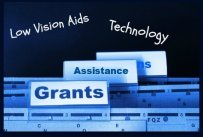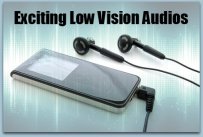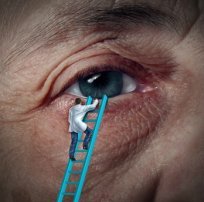Low Vision Driving
Why Bi-Optics May Be Necessary

Low Vision Driving:
It is crucial to visit your eye doctor regularly to track any changes in your vision, especially if you plan to continue driving. This is my story about trying to renew my license in the face of my own diminishing vision.
My Low Vision Driving
License Renewal
It came: my dreaded drivers license renewal notice. I knew my vision was getting worse and that I would likely have to retake all of the licensing tests. In Illinois, where I live, there are strict guidelines in place when it comes to vision loss and driving. Once our eyes reach a certain level, we are required to renew each year and bioptic lenses may be required. For reference, my state’s Low Vision Driving specific vision requirements are:
1 ) Visual Acuity: at least 20/40 in the better eye (this is with or without corrective lenses).Otherwise, at least 20/100 in the better eye, or 20/40 through a bioptic telescope (with restrictions).With20/70 in the better eye: restricted license (daylight only).
2) Visual Field: with two eyes, 140-degree field of vision required. Monocular vision requires 70-degree temporally and 35-degree nasally.
With these restrictions in mind, I made an appointment with my ophthalmologist at the Veteran’s Hospital in order to see how much my vision had changed. In the meantime, I requested special paperwork from the DMV for my doctor to fill out at my appointment.
The Appointment
To put it simply, I was nervous. I tried to distract myself with music through my ear buds, but mostly had to entertain my own anxious thoughts while waiting to be called back. Once the testing began, my heart dropped as I realized just how much my vision had changed. I tried to look using my right eye but could barely read anything below the chart’s third row.
Several years ago I had a vision mapping done, which I highly recommend to anyone with low vision. Your doctor will help you pinpoint the spot where your vision is best, then supply you with exercises meant to train your eye to use that spot to see. My vision mapping revealed that my right eye was weakening, so my doctor gave me many specific training exercises that helped my left eye maintain its vision.
Now, at my new appointment, the doctor’s assistant helped me discover that my left eye had taken over dominance and was overcompensating for the diminishing vision loss of my right eye. All my optimism fled as I realized that my Low Vision Driving days were probably over. My left eye read at the 20/100 level, but my right eye read at 20/200 and was now considered legally blind.
Detailed Results and Good News with a Stipulation
My doctor retested my eyes with and without my glasses, and then offered me a 3-times power bioptic. It did not help my right eye but gave me 20/40 vision in my left eye, renewing my hopes of being able to drive. My doctor used a new technology called digital retinal photography to take clear pictures of my eyes against a special screen. These images are immediately available for review and show the inside of each eye so you can understand the detailed conditions.
I couldn’t keep in my smile as my doctor announced that I would be able to continue driving, after all. I would have to have bioptics specially made, but I was just happy to learn that there was a solution. The low vision office ordered my bioptics and sent me home. The Veteran’s Hospital then called, warning me not to drive again until the bi optics came in. I immediately started stressing about how I was going to get to and from work. Additionally, I was told I would have to undergo even more testing at the Hines Blind Center. So many hurdles stood between me and my goal, but I was determined not to give up.
Transportation Issues
At the Hines Blind Center the following week, I underwent testing including charts, visual peripheral acuity, and bioptics. Unfortunately, I was then told that it could take up to two months for my bioptics to arrive. My Low Vision Driving would need to stop and i would have to rely upon others to help me get anywhere I needed to go.
Several years ago, vision issues cost me my ability to drive for two years. That time away from driving strengthened me, though, because this time around I knew exactly what to do. I placed a circular on the bulletin board of my living community, visited the senior center for information about potential drivers, looked in the newspaper, and contacted Pace Paratransit services, which operates door-to-door as well as with trains and buses. In addition, I discovered that some local taxi services offer a reduced rate for those with low vision.
My Low Vision Driving Results For Now

For me, the community circular did the trick. I am very happy with my driver and the fee we agreed upon for the days I need help. Other times, I happily cruise around on my electric bicycle, made by Pedego out of California. It can go about 20 mph, and enables me to get myself to and from work on good days. I now also have the use of the para transit services. This means i have door to door service. I use them to get to and from the train station for transport into Chicago. I primarily use the community center bus for getting to grocery stores and shopping centers.
As you can see, you must approach this from many directions at the same time. Having a handle on your transportation options is essential for maintaining your independence. Do not give up on trips and activities just because you suffer from vision loss. It is a learning process, so find a community of others with which you can share information like this.
I am still waiting for my bioptics, but you will be among the first I tell about how they work. I will also share all of my final steps in the process for my Low Vision Driving. in case you wind up in a similar situation.
My Journey’s Final Steps
Six months after ordering my Bi-Optics, they have arrived. They fit well and are exactly what I ordered and expected, and I am happy to have them back again.The arrival of the Bi-Optics is bittersweet, however, because I have stopped driving my vehicle. I had previously planned to test my vision once the Bi-Optics arrived, in order to see if my aided eyesight would meet the driver’s license vision requirements in Illinois. Unfortunately, this is no longer an option for me. I have sold my vehicle and will no longer take the seat behind the wheel. This decision and transition were difficult to face, but this was a must for me since my vision will no longer give me the required numbers for driving.
Thankfully, however, I will be able to use my Bi-Optics while on my bike. I plan to take full advantage of biking with Bi-Optics once spring arrivesand look forward to using them then. In the meantime, though, I am very grateful to have my driver to help me get around. I also still use the paratransit for door-to-door service, and my new RTA card allows me to ride the local bus and trains for free. All of these transportation options are very helpful and make getting around quite easy. Along with my bike and Bi-Optics in better weather, I have all of my bases covered for now where travel is concerned. There arestill some times that I miss my car. On a day like today here in and around Chicago, however, it is snowing very heavily and the streets are a mess, so I am very happy not to be out on them.
All in all, this process has been quite a journey for me. It began last May when I received my renewal notice from the DMV, and it has brought me to this point nearly nine months later. In some ways, the loss of some of my vision has made me a stronger person. I am not hesitant or afraid to try anything new, such as innovative apps that help me read, see more clearly, or get me to a destination via GPS. In fact, I am having fun with all of the technology that is coming our way. I can still use my computer thanks to magnification and reading programs, and I can even talk to my phone to send a text message. I am especially grateful for my website, which gives me the tools that I can then pass on to others with conditions just like mine. After all, that’s what it is all about: helping others, so that they will in turn help other individuals, and so on and so on.
Besides, even though I will not be using the Bi-Optics for driving as I originally planned, my journey does not really end. Instead, my personal journey has renewed itself with a new challenge for my eyes. I have recently ordered the newest technology available, Orcam, which I fully believe will revolutionize this industry. The Orcam comes from Israel and is essentially a small, wearable camera that attaches to glasses and allows the visually impaired to see.You can read more about it on the home page of my website, and there will be postings all about my new journey with OrCam to follow.

















